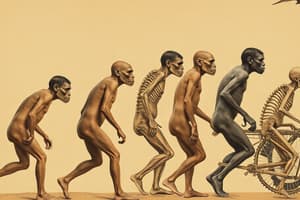Podcast
Questions and Answers
What is nicknamed 'Lucy's baby'?
What is nicknamed 'Lucy's baby'?
Recently, fossil remains of a three-year-old child.
What is the most famous Australopithecus africanus?
What is the most famous Australopithecus africanus?
Taung child
What is Turkana Boy also called?
What is Turkana Boy also called?
Nariokotome Boy
Who is the best-known Neanderthal that survived several injuries?
Who is the best-known Neanderthal that survived several injuries?
What is La Chapelle aux Saints known for?
What is La Chapelle aux Saints known for?
What do Omo 1 and 2 represent?
What do Omo 1 and 2 represent?
What is the difference between robust and gracile australopithecines?
What is the difference between robust and gracile australopithecines?
What species does Australopithecus afarensis belong to?
What species does Australopithecus afarensis belong to?
What is the age range of Australopithecus afarensis?
What is the age range of Australopithecus afarensis?
What are some key features of Australopithecus africanus?
What are some key features of Australopithecus africanus?
Which of the following is considered a robust australopithecine?
Which of the following is considered a robust australopithecine?
What is the significance of Homo habilis?
What is the significance of Homo habilis?
What is the age range of Homo erectus?
What is the age range of Homo erectus?
What technology is associated with Neandertals?
What technology is associated with Neandertals?
What does the Out of Africa theory propose?
What does the Out of Africa theory propose?
Which of the following statements is true about Homo sapiens neanderthalensis?
Which of the following statements is true about Homo sapiens neanderthalensis?
Define Bergmann's and Allen's rules.
Define Bergmann's and Allen's rules.
What is the significance of the term 'Anatomical modernity'?
What is the significance of the term 'Anatomical modernity'?
What is a common feature of Homo floresiensis?
What is a common feature of Homo floresiensis?
What was the evolutionary significance of Lucy?
What was the evolutionary significance of Lucy?
Flashcards are hidden until you start studying
Study Notes
Australopithecines
- Gracile australopithecines (e.g., A. afarensis, A. africanus) are characterized by lighter build, smaller teeth, and varied diets; robust forms (e.g., A. robustus, A. boisei) are more robust, with larger teeth and specialized for tough vegetation.
- Australopithecus afarensis is a key early ancestor, found in East Africa, about 3.5-2.6 million years old, with brain size comparable to modern chimpanzees.
- Australopithecus africanus, from South Africa, shows features indicating upright posture, lived about 3-2 million years ago, and had a small cranial capacity.
- Australopithecus boisei, discovered in Olduvai Gorge, had robust cranial traits and large teeth, living around 1.75 million years ago.
- Australopithecus robustus, from South Africa, is about 2-1.5 million years old, shares robust traits, and possibly descended from A. afarensis.
Early Homo Species
- Homo habilis represents the first species of the genus Homo, lived 2.4-1.4 million years ago, known for significant brain size increase and use of stone tools, primarily scavenging rather than hunting.
- Homo erectus/ergaster, existing from 1.8 million to 300,000 years ago, was the first to migrate out of Africa; it had a more human-like body ratio and advanced tools known as the Acheulian Complex.
Neanderthals and Their Culture
- Homo sapiens neanderthalensis, existing from 130,000 to 30,000 years ago, adapted to cold climates, utilized Mousterian stone tools, and displayed signs of culture, including burial rituals and potential symbolic behavior.
- Evidence suggests Neanderthals were not extinct but assimilated into modern human populations due to interbreeding.
Unique Human Ancestors
- Homo floresiensis, dubbed the "Hobbit," was a small human-like species found in Indonesia, potentially misclassified; existed alongside modern humans.
- Homo sapiens sapiens, modern humans, had advanced technology and symbolic behavior, spreading globally from Africa approximately 200,000 years ago.
Tools and Technological Advances
- Lomewki technology (3.3 million years ago) represents the oldest stone tools, possibly linked to early human ancestors.
- Oldowan tools (2.5 million years ago) marked the start of tool use by Homo habilis.
- Acheulean technology introduced more refined stone tools around 1.7 million years ago, primarily associated with Homo erectus.
- Upper Paleolithic period (10,000 years ago) saw finely crafted tools reflecting early modern human technological advances.
Evolutionary Theories
- Out of Africa theory posits modern humans evolved in Africa and replaced archaic populations, while Multiregional theory suggests regional development without replacement.
- Genetic studies show greater variation in African populations, supporting the Out of Africa hypothesis.
Agricultural Developments
- Around 10,000 years ago, agriculture began, significantly altering diets and lifestyles.
- Advantages of domestication include population support and food surplus; disadvantages encompass environmental degradation and health-related issues.
Anatomy and Physiology
- Various anatomical features differentiate human ancestors: cranial capacity, robusticity, and postures indicate evolutionary adaptations.
- Bergmann's and Allen's rules describe body size adaptations to climate, exemplified by Neanderthals' robust physiques in cold habitats.
Notable Fossils
- Significant fossils reveal evolutionary history, including Lucy (Australopithecus afarensis), Turkana Boy (Homo erectus youth), and Shanidar fossils (Neanderthals), showcasing survival and potential care among hominins.
- Omo fossils represent early modern human remains crucial for understanding human evolution.
This collection of notes encapsulates the evolution of early human ancestors and their cultural and technological advancements.
Studying That Suits You
Use AI to generate personalized quizzes and flashcards to suit your learning preferences.





